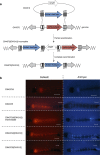Site-specific cassette exchange systems in the Aedes aegypti mosquito and the Plutella xylostella moth
- PMID: 25830287
- PMCID: PMC4382291
- DOI: 10.1371/journal.pone.0121097
Site-specific cassette exchange systems in the Aedes aegypti mosquito and the Plutella xylostella moth
Abstract
Genetically engineered insects are being evaluated as potential tools to decrease the economic and public health burden of mosquitoes and agricultural pest insects. Here we describe a new tool for the reliable and targeted genome manipulation of pest insects for research and field release using recombinase mediated cassette exchange (RMCE) mechanisms. We successfully demonstrated the established ΦC31-RMCE method in the yellow fever mosquito, Aedes aegypti, which is the first report of RMCE in mosquitoes. A new variant of this RMCE system, called iRMCE, combines the ΦC31-att integration system and Cre or FLP-mediated excision to remove extraneous sequences introduced as part of the site-specific integration process. Complete iRMCE was achieved in two important insect pests, Aedes aegypti and the diamondback moth, Plutella xylostella, demonstrating the transferability of the system across a wide phylogenetic range of insect pests.
Conflict of interest statement
Figures



Similar articles
-
Cre/lox-Recombinase-Mediated Cassette Exchange for Reversible Site-Specific Genomic Targeting of the Disease Vector, Aedes aegypti.Sci Rep. 2017 Mar 7;7:43883. doi: 10.1038/srep43883. Sci Rep. 2017. PMID: 28266580 Free PMC article.
-
High efficiency, site-specific excision of a marker gene by the phage P1 cre-loxP system in the yellow fever mosquito, Aedes aegypti.Nucleic Acids Res. 2003 Nov 15;31(22):e147. doi: 10.1093/nar/gng148. Nucleic Acids Res. 2003. PMID: 14602940 Free PMC article.
-
Genetic control of Plutella xylostella in omics era.Arch Insect Biochem Physiol. 2019 Nov;102(3):e21621. doi: 10.1002/arch.21621. Epub 2019 Sep 20. Arch Insect Biochem Physiol. 2019. PMID: 31538676 Review.
-
Recombinase-mediated cassette exchange (RMCE) - a rapidly-expanding toolbox for targeted genomic modifications.Gene. 2013 Feb 15;515(1):1-27. doi: 10.1016/j.gene.2012.11.016. Epub 2012 Nov 29. Gene. 2013. PMID: 23201421 Review.
-
Improvement on the genetic engineering of an invasive agricultural pest insect, the cherry vinegar fly, Drosophila suzukii.BMC Genet. 2020 Dec 18;21(Suppl 2):139. doi: 10.1186/s12863-020-00940-5. BMC Genet. 2020. PMID: 33339511 Free PMC article.
Cited by
-
Efficient hyperactive piggyBac transgenesis in Plodia pantry moths.Front Genome Ed. 2022 Dec 23;4:1074888. doi: 10.3389/fgeed.2022.1074888. eCollection 2022. Front Genome Ed. 2022. PMID: 36620082 Free PMC article.
-
Molecular tools and genetic markers for the generation of transgenic sexing strains in Anopheline mosquitoes.Parasit Vectors. 2018 Dec 24;11(Suppl 2):660. doi: 10.1186/s13071-018-3207-8. Parasit Vectors. 2018. PMID: 30583738 Free PMC article. Review.
-
Cre/lox-Recombinase-Mediated Cassette Exchange for Reversible Site-Specific Genomic Targeting of the Disease Vector, Aedes aegypti.Sci Rep. 2017 Mar 7;7:43883. doi: 10.1038/srep43883. Sci Rep. 2017. PMID: 28266580 Free PMC article.
-
Biological Control Strategies for Mosquito Vectors of Arboviruses.Insects. 2017 Feb 10;8(1):21. doi: 10.3390/insects8010021. Insects. 2017. PMID: 28208639 Free PMC article. Review.
-
Mimicking superinfection exclusion disrupts alphavirus infection and transmission in the yellow fever mosquito Aedes aegypti.Proc Natl Acad Sci U S A. 2023 Sep 12;120(37):e2303080120. doi: 10.1073/pnas.2303080120. Epub 2023 Sep 5. Proc Natl Acad Sci U S A. 2023. PMID: 37669371 Free PMC article.
References
-
- Benedict M, D’Abbs P, Dobson S, Gottlieb M, Harrington L, Higgs S, et al. (2008) Guidance for contained field trials of vector mosquitoes engineered to contain a gene drive system: recommendations of a scientific working group. Vector Borne Zoonotic Dis 8: 127–166. 10.1089/vbz.2007.0273 - DOI - PubMed
Publication types
MeSH terms
Substances
LinkOut - more resources
Full Text Sources
Other Literature Sources

